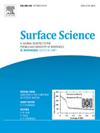Exploring the atomic-scale dynamics of Fe3O4(001) at catalytically relevant temperatures using FastSTM
IF 2.1
4区 化学
Q3 CHEMISTRY, PHYSICAL
引用次数: 0
Abstract
Surfaces and interfaces of functional nanoscale materials are typically highly dynamic when employed at elevated temperatures. Both, lateral surface and vertical bulk exchange diffusion processes set in, which can be relevant for applications such as heterogeneous catalysis. Time-resolved scanning tunneling microscopy (STM) is being pushed to ever faster measurement modes to follow such dynamic phenomena in situ. Here, we present FastSTM movies monitoring a range of atomic-scale dynamics of a prototypical reducible oxide catalyst support, Fe3O4(001), at elevated temperatures. Antiphase domain boundaries between two domains of the reconstructed surface exhibit local mobility from around 350 K, while Fe-rich point defects, in a stable equilibrium with the bulk, appear to diffuse in a peculiar zigzag pattern above 500 K. Finally, exploiting the diffusivity of Fe interstitials, we follow the propagation of step edges in the topmost atomic layer of the Fe3O4(001) surface in an oxygen atmosphere.

利用 FastSTM 探索催化相关温度下 Fe3O4(001) 的原子尺度动力学特性
功能纳米材料的表面和界面在高温条件下通常具有很强的动态性。横向表面和纵向块体交换扩散过程都会发生,这可能与异相催化等应用有关。时间分辨扫描隧道显微镜(STM)正被推向更快的测量模式,以现场跟踪此类动态现象。在这里,我们展示了在高温下监测原型可还原氧化物催化剂载体 Fe3O4(001) 的一系列原子尺度动态的 FastSTM 电影。重构表面的两个畴之间的反相畴边界从 350 K 左右开始表现出局部流动性,而与块体处于稳定平衡状态的富铁点缺陷则在 500 K 以上以奇特的之字形模式扩散。
本文章由计算机程序翻译,如有差异,请以英文原文为准。
求助全文
约1分钟内获得全文
求助全文
来源期刊

Surface Science
化学-物理:凝聚态物理
CiteScore
3.30
自引率
5.30%
发文量
137
审稿时长
25 days
期刊介绍:
Surface Science is devoted to elucidating the fundamental aspects of chemistry and physics occurring at a wide range of surfaces and interfaces and to disseminating this knowledge fast. The journal welcomes a broad spectrum of topics, including but not limited to:
• model systems (e.g. in Ultra High Vacuum) under well-controlled reactive conditions
• nanoscale science and engineering, including manipulation of matter at the atomic/molecular scale and assembly phenomena
• reactivity of surfaces as related to various applied areas including heterogeneous catalysis, chemistry at electrified interfaces, and semiconductors functionalization
• phenomena at interfaces relevant to energy storage and conversion, and fuels production and utilization
• surface reactivity for environmental protection and pollution remediation
• interactions at surfaces of soft matter, including polymers and biomaterials.
Both experimental and theoretical work, including modeling, is within the scope of the journal. Work published in Surface Science reaches a wide readership, from chemistry and physics to biology and materials science and engineering, providing an excellent forum for cross-fertilization of ideas and broad dissemination of scientific discoveries.
 求助内容:
求助内容: 应助结果提醒方式:
应助结果提醒方式:


